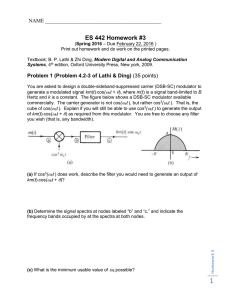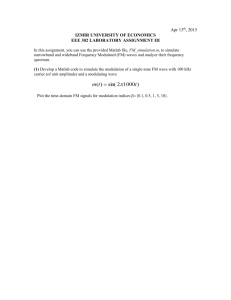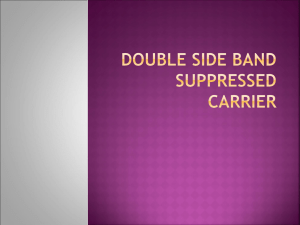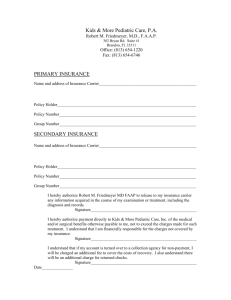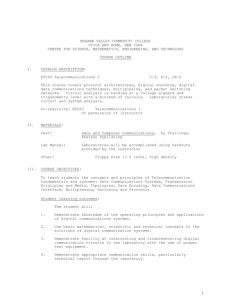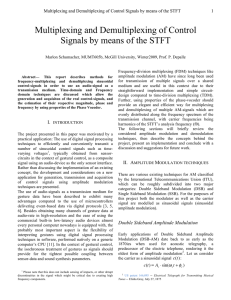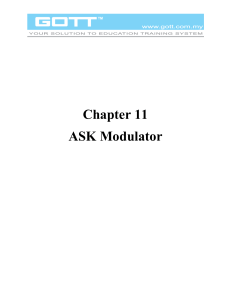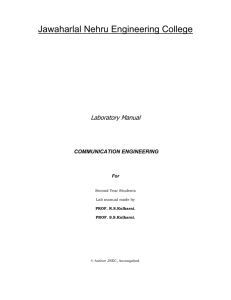Electronic Communications
advertisement
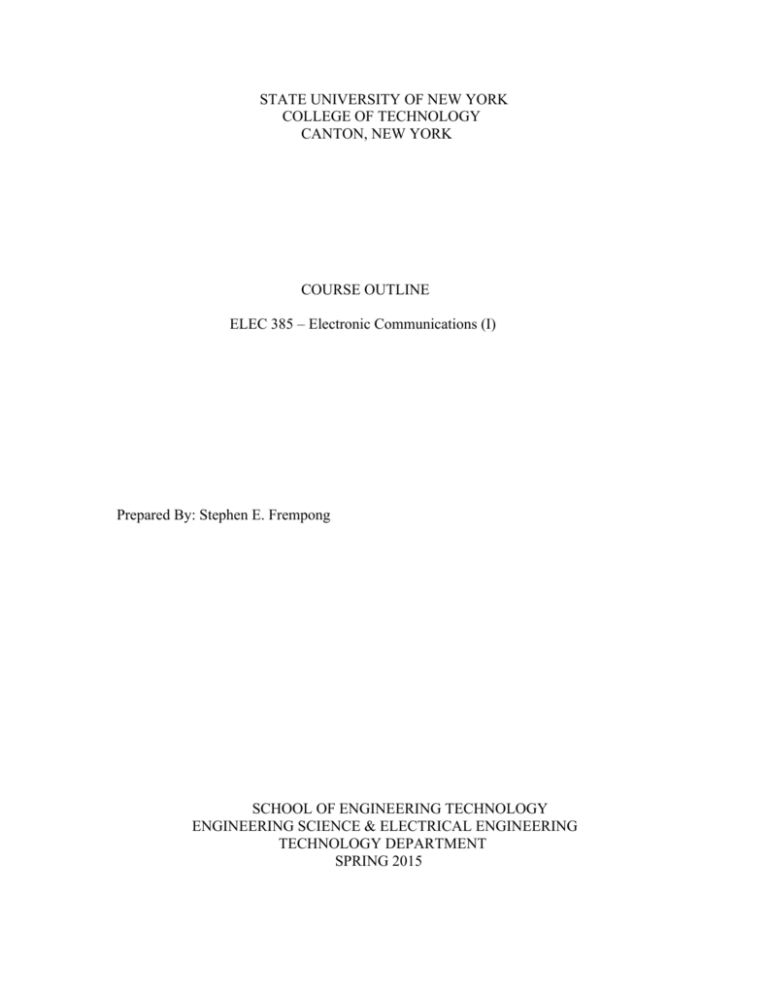
STATE UNIVERSITY OF NEW YORK COLLEGE OF TECHNOLOGY CANTON, NEW YORK COURSE OUTLINE ELEC 385 – Electronic Communications (I) Prepared By: Stephen E. Frempong SCHOOL OF ENGINEERING TECHNOLOGY ENGINEERING SCIENCE & ELECTRICAL ENGINEERING TECHNOLOGY DEPARTMENT SPRING 2015 A. TITLE : Electronic Communications (I) B. COURSE NUMBER: ELEC 385 C. CREDIT HOURS: 3 D. WRITING INTENSIVE COURSE: NO E. WEEKS PER SEMESTER: 15 F. SEMESTER OFFERED: SPRING G. HOURS OF LECTURE, LABORATORY, RECITATION, TUTORIAL, ACTIVITY: 2 hours lecture and 2 hours laboratory per week H. CATALOG DESCRIPTION: The first of a two series of courses to prepare students for modern telecommunications industry. Topics covered include: Noise, Transmission Lines, Wave Propagations, Error Checking, Communication Transmitters/Receivers, Coding Techniques, and Computer Communications. I. PRE-REQUISITES/CO-COURSES: ELEC225 [Telecommunications], Electronic Circuits (ELEC 231), and Calculus II (MATH 162), or permission of instructor. J. GOALS (STUDENT LEARNING OUTCOMES) By the completion of this course, seventy percent of the students will be able to: Course Objectives (STUDENT LEARNING OUTCOMES) Determine the AM carrier power given the power in one sideband and the percent modulation. Determine the Total Harmonic Distortion produced by an amplifier from a spectrum analyzer display of the output signal. Institutional SLO* Determine the amount of frequency deviation that is produced in a varactor phase modulator circuit, when the modulating frequency is 1000 Hz and the carrier frequency is 1.2 MHz. Design a LCC "T" network using a Q of 11 that will match the 7 ohm internal resistance of an active element (Transistor) to a 50 ohm load at 50 MHz. 2. Critical Thinking 3. Professional Competence 2. Critical Thinking 3. Professional Competence 2. Critical Thinking 3. Professional Competence 2. Critical Thinking 3. Professional Competence *Intuitional Student Learning Objectives (SLO): * (1) Communication, (2) Critical Thinking, (3) Professional Competence, (4) Inter-Intrapersonal Skills K. TEXTS: Louis E. Frenzel, Principles of Electronic Communication Systems, 2nd Edition, 8787 Orion Place, Columbus, OH 43240: Glencoe/McGraw-Hill, 2003. OR, as determined by instructor. L. REFERENCES: 1. Gary M. Miller, Modern Electronic Communication, 6th Edition, Upper Saddle River, New Jersey: Prentice Hall, 2004. 2. Wayne Tomasi, Electronic Communications Systems, 5th Edition, Upper Saddle River, New Jersey: Prentice Hall, 2004. M. EQUIPMENT: Students are required to purchase laboratory components. N. GRADING METHOD: A-F O. MEASUREMENT CRITERIA/METHODS: Examination performance, Assignment, and Laboratory project. P. DETAILED TOPICAL OUTLINE: 1. Introduction to Electronic Communications a. Power Measurements b. Electronic Communications Systems c. Electromagnetic Frequency Spectrum d. Noise Analysis 2. Signal Analysis and Mixing a. Complex Waves b. Frequency Spectrum and Bandwidth c. Fourier Series for a Rectangular Waveform 3. Coding Techniques a. Introduction b. Coding c. Alphanumeric Codes d. Digital Signal Encoding Formats e. Code Error Detection and Correction f. PCM Analysis g. Delta Modulation h. PCM/TDM Repeaters 4. Single-Sideband Communications Systems a. Single-Sideband Systems b. Comparison of Single-Sideband Transmission to Conventional AM c. Mathematical Analysis of Suppressed Carrier AM d. Single-Sideband Transmitters/Receivers e. Double-Sideband Suppressed Carrier and Quadrature Multiplexing f. Single-Sideband Measurements 5. Transmission Lines a. Types of Transmission Lines b. Electrical Characteristics of Transmission Lines c. Propagation of DC Voltage Down a Line d. Nonresonant Line e. Standing Wave Ratio f. Transmission Line Applications 6. Digital Modulation a. Information Capacity (bits, bit rate and baud) b. Amplitude Shift Keying c. Frequency Shift Keying d. Phase Shift Keying e. Quadrature Amplitude Modulation f. Bandwidth Efficiency g. Carrier Recovery h. Differential Phase Shift Keying i. Trellis Code Modulation j. PCM 7. Digital T-Carriers and Multiplexing a. T1 Digital Carrier b. Digital Carrier Line Encoding c. T Carrier Systems d. European Digital Carrier System e. Statistical Time Division Multiplexing f. AT&T’s FDM Hierarchy g. Composite Baseband Signal h. Wavelength Division Multiplexing Q. LABORATORY OUTLINE: 1. Oscillator Circuit 2. AM Modulator Circuit Design 3. FM Modulator Circuit Design 4. Demodulator Circuits (AM, FM) 5. Single Sideband Circuit Design and Measurements 6. FDM Circuit Design 7. AD/DA Convertors 8. Pulse Width Modulator 9. Frequency Multiplier 10. Frequency Demodulation 11. Final Project


